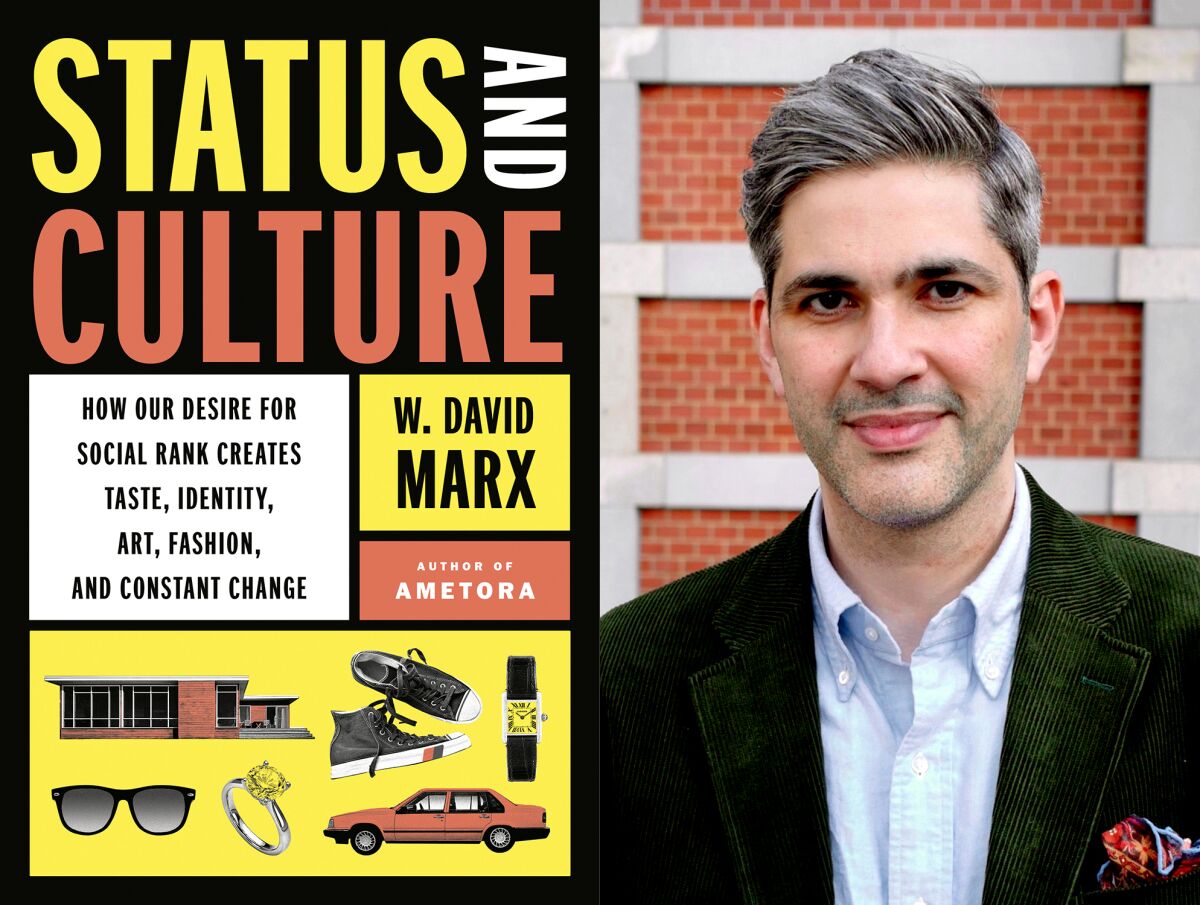On the Shelf
Two Books on Hip-Hop, Bling and Status
Ice Cold: A Hip-Hop Jewelry History
By Vikki Tobak
Taschen: 388 pages, $100
Status and Culture: How Our Desire for Social Rank Creates Taste, Identity, Art, Fashion, and Constant Change
By W. David Marx
Viking: 368 pages, $30
If you buy books linked on our site, The Times may earn a commission from Bookshop.org, whose fees support independent bookstores.
When early humans first ornamented themselves with stones or seashells, they invented glittering status symbols to evoke admiration and/or envy. Eons later, few contemporary figures have embraced jewelry’s aspirational potential more than hip-hop artists. Kurtis Blow was a pioneer, sporting half a dozen gold chains on the cover of his self-titled 1980 debut; those now look like wispy strands compared with today’s bedazzled concoctions of conspicuous consumption. Cam’ron’s ethos on “Get ’Em Girls” (2004) said it all: “I style up in my gear … medallions in my ear, whips on my fists, houses on my wrists.”
The desire to wear one’s wealth can come at a heavy cost beyond the monetary. On Sept. 12, a group conspiring to rob PnB Rock of his jewelry killed the Philly rapper outside an L.A. restaurant. Days later, veteran rapper-actor Ice-T tweeted that prominent, local rappers like Snoop Dogg and Kendrick Lamar “don’t wear a lotta Jewelry” because “LA is just a Dangerous place. … Why test the streets.”

Those who haven’t yet attained Snoop status might still feel it’s worth the risk. Vikki Tobak’s new book, “Ice Cold: A Hip-Hop Jewelry History,” chronicles the long affinity between rap artists and their adornments. It follows on her “Contact High: A Visual History of Hip-Hop” (2018), an exceptional anthology of hip-hop photography whose influence carries into the thousand-odd images that fill her latest book. Organized by decade, “Ice Cold” illustrates the hip-hop arms race to procure and produce increasingly elaborate, individualized showpieces.
What began in the 1980s with Run DMC and Eric B. & Rakim wearing muscular, “dookie” gold chains has exploded into a scintillating diversity of door-knocker earrings, custom four-finger rings, black leather Africa medallions and jewel-studded dental grills. “Ice Cold” includes both the iconic — Biggie’s diamond-encrusted “Jesus piece” designed by Tito Caicedo of Manny’s — and esoteric — Cardi B’s gold cache pasties from Bijules. For literal moxie, peep T-Pain’s $400,000 pendant from Icebox Jewelers, with 200 carats of diamonds spelling out “Big Ass Chain.”
Although “Ice Cold” is primarily focused on creations, Tobak tries to give the creators some shine too, writing valuable, albeit brief, backgrounds of key figures, including New York’s legendary “Jacob the Jeweler” Arabo, Houston’s “TV Johnny” Dang and Los Angeles’ “Ben Baller” Yang. Not only are they artists too, crafting with carats rather than rhymes, but Tobak notes how many jewelers, like their hip-hop clients, come from humble beginnings.

Megan Thee Stallion, as shown in “Ice Cold,” sports her “Hot Girl” moniker pendant by Eliantte & Co. Los Angeles, 2020
(Marcelo Cantu)
While serving as a compendium of opulence and excess, “Ice Cold” emphatically ties bling’s symbolism to lived realities of social marginalization. Contributor LL Cool J writes, “the hustlers I saw parading their jewelry all over New York City … equaled hope.” Slick Rick adds, “when the luxury brands fall short and don’t serve us, we create our own luxury.” ASAP Ferg’s analogy of jewelry as fine art is especially provocative: “I look at it like buying a Damien Hirst painting and wearing a Francis Bacon around your neck.”
The risks posed by flashy jewelry are real, but so are the social rewards. As Tobak suggests, these pieces are a “declaration of dopeness, power, domination, and wealth.” She would find strong agreement from author W. David Marx. In “Status and Culture,” released last month, he writes, “the most rational way to move up the social hierarchy is to convert raw wealth into status symbols.” Nouveau riche rappers, draped in drip, signal success much like a third-generation banker suiting up in Savile Row.

The three members of Migos are significant collectors of jewelry. In this photograph from “Ice Cold,” most of the bling on Takeoff (from left), Offset and Quavo is by Eliantte & Co. Los Angeles, 2018
(Travis Shinn)
However, as Marx (and many a TV drama) reminds us: “Old Money loathes New Money.” The former’s high status influences the perception that its profligate spending is tastefully cultured while New Money’s habits are desperately gauche. For Marx, these struggles over status power “perpetual cultural change” by motivating the invention or pursuit of new ideas out of a desire to protect and bolster our social ranking.
Marx’s previous book, “Ametora: How Japan Saved American Style” (2015), was an engaging, insightful history of the cross-cultural influences between American and Japanese menswear trends. Compared to “Ametora’s” niche focus, “Status and Culture” is an ambitiously sweeping treatise. Like Malcolm Gladwell’s “The Tipping Point” or Chris Anderson’s “The Long Tail,” it synthesizes years of social science research and claims to unlock simple but powerful explanations of our social world, in this case via the skeleton key of status.
“We all compete for status, whether we like it or not,” Marx insists, but how we go about it depends on where we’re already positioned. He argues that those with low status have little to lose in advancing new cultural standards; think of punk and hip-hop’s working-class roots and fixations on “authenticity” and “realness.” Meanwhile, social elites possess enough surplus status to gamble on unconventional ideas — haute couture for example — that others might find too outrageous to adopt.

“Status and Culture,” by W. David Marx
(Viking)
The middle classes, stuck in between and having the most to lose, are prone to being the most risk-averse; it’s why middlebrow tastes are considered “respectable” yet blandly conventional. In the late 20th century, the splintering off of a creative class inspired a new ideal of “competing on taste” by emphasizing cultural capital (privileged knowledge). This involves mastering status signals from both above and below, whether that means attending prestigious schools, collecting obscure band T-shirts, becoming a whiskey connoisseur or … writing book reviews in major newspapers.
Alas, according to Marx, the information age has weakened cultural capital’s value. The internet has made niche knowledge easily attainable, even as gatekeeping regimes of taste have withered under the popularization of egalitarian principles. All this makes naked displays of wealth even more attractive in broadcasting status, especially when amplified via social media. New Money, fueled by tech, finance, oil, celebrity, etc., creates new markets for ultra-luxe goods and services, displacing older, aristocratic conventions with newer, plutocratic ones. Yet despite Silicon Valley’s disruptions, status remains evergreen; only the shades change.

ASAP Rocky, as seen in “Ice Cold,” boasts three-piece cap grills of diamonds and yellow gold. Los Angeles, 2018
(Mike Miller)
What makes status especially pernicious is that it doesn’t just influence cultural trends; it also shapes our sense of personhood. We’re told, ad nauseam, “just be yourself,” but Marx reminds us originality is traditionally an “aristocratic privilege.” Even claiming “I don’t care about status” is a hoary marker of status, signaling one’s virtuous ascension above the material rabble.
Again: it’s easy to disavow status when you already have it. In “Ice Cold,” LL shares how he forgoes his dookie chains now that his stature as a celebrated actor and artist frees him from having to “prove to people that I have money.” However, for young artists aspiring to reach LL’s level of success — like the late PnB Rock — bling still provides an alluring shortcut to status despite the risks.
Marx doesn’t believe the influence of status can ever be transcended, but he suggests we can at least narrow its stratifications by reducing “the ills of social hierarchy” and promoting “radical creativity.” Status inequality would persist but, Marx argues, at least “creativity is more equally distributed across society than the ability to mint wealth.” One need only peruse “Ice Cold” to see this idea play out in dazzling detail. Hip-hop jewelry might have its roots in conspicuous consumption, but it’s also a form of creative expression, as unique to an artist as flow or songwriting. Anyone with money can buy a gold chain, but before Biggie, no one thought of commissioning a custom Jesus piece.

Slick Rick kicks it old school with pieces purchased mostly from jewelers on Canal Street. New York, 1999
(Clay Patrick McBride)
Ultimately, if status is tied to our basic need to feel respected or admired, it would be disastrous if we perceived wealth to be the only legible path toward attaining it. A call for radical creativity encourages alternate forms of recognition. Past examples abound — Teddy boys in 1950s England, hip-hop sound systems in ‘70s New York — and new ones emerge all the time, from TikTok dancers in India to cottagecore adoptees in Canada.
Many of these trends will prove ephemeral. The ones that last are often defanged and cannibalized by the mainstream. Few will ever be truly revolutionary. Yet our status-fueled desire to invent and explore new forms of being and belonging remain fundamental to how we prevent cultures — and ourselves — from calcifying into stasis. We may all be bound by status’ gravity, but we need not always feel trapped by it.
Wang is a professor of sociology at CSU Long Beach.
For all the latest Entertainment News Click Here
For the latest news and updates, follow us on Google News.
